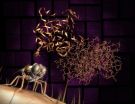(Press-News.org) Montreal, December 6, 2012 – Rows of new toys, endless racks of sweaters on clothing store shelves, long lines of books arranged in the bestsellers section at the bookstore. From mall displays to boutique exhibits, long lines of horizontally arranged products are the norm when it comes to the holiday shopping experience.
But how does a product's placement on the storeroom shelf influence which one a consumer ultimately chooses? It turns out that the shopper's eye has a very central focus.
"Consumers are more likely to purchase products placed in the middle of a display – without even being aware of it," says Onur Bodur. The associate professor from Concordia's John Molson School of Business is co-author of a recent study in the Journal of Consumer Research, along with marketing researchers at HEC in France and the Aston Business School in England.
Using eye-tracking devices, Bodur and his colleagues investigated how location influences choices for a variety of products, including cosmetics and food items.
They found that consumers would increase their visual focus on the central option in a product display area in the final five seconds of the decision-making process – and that was the point at which they determined which option to choose.
It turns out that the process is a subconscious one. When asked how they had come to choose which product to buy, consumers did not accurately recall their reasons for their decision. What's more, they were not aware of any conscious visual focus on one area of the display over another.
What does uncovering these unconscious habits mean for the average shopper? Greater awareness of buying behaviours should lead to more informed choices. Says Bodur, "by using this newfound knowledge that visual attention is naturally drawn to the center of a display, consumers can consciously train themselves to make a more thorough visual scan of what's on offer."
When it comes to holiday shopping, the visual equivalent to thinking outside of the box just might lead to savvier selections.
###Related links:
John Molson School of Business http://johnmolson.concordia.ca/index.php
H. Onur Bodur http://johnmolson.concordia.ca/en/faculty-research/profiles/h-onur-bodur
Journal of Consumer Research http://ejcr.org/
Media contact:
Cléa Desjardins
Senior Advisor, External Communications
Concordia University
Tel: 514-848-2424, ext. 5068
Cell: 514-909-2999
e-mail: clea.desjardins@concordia.ca
Web: concordia.ca/media-relations
Twitter: twitter.com/CleaDesjardins
Closer look at consumers' gazes
Concordia research proves shoppers are drawn to centrally placed products
2012-12-06
ELSE PRESS RELEASES FROM THIS DATE:
Prenatal tests more informative using microarray technology, find GW researchers
2012-12-06
WASHINGTON – A new method for detecting abnormalities in unborn children is providing physicians with more information to analyze the results than conventional, microscopic testing, according to two George Washington University researchers.
Elizabeth Thom, research professor of epidemiology and biostatistics, and Julia Zachary, senior research scientist, are co-authors of the lead article appearing in the current issue of the New England Journal of Medicine showing that microarray technology provides a more comprehensive result from genetic testing during prenatal care ...
UT MD Anderson study finds link between statins and improved survival in inflammatory breast cancer
2012-12-06
HOUSTON - Researchers from The University of Texas MD Anderson Cancer Center found statins, the commonly used drug to lower cholesterol, improved progression-free survival in patients with inflammatory breast cancer (IBC).
The retrospective study was presented today in a poster discussion at the 2012 CTRC-AACR San Antonio Breast Cancer Symposium and follows a previously reported Danish study indicating there is some evidence to suggest the anti-inflammatory properties of statins could reduce the risk of breast cancer recurrence. Still, the overall effects of statins have ...
Insect-eating bat outperforms nectar specialist as pollinator of cactus flowers
2012-12-06
SANTA CRUZ, CA--Of the two bat species known to visit the flowers of the cardon cactus in Baja California, one depends entirely on nectar and is highly specialized to feed from the flowers, which are adapted for pollination by bats. The other is an insect-eating bat best known for its ability to hear the footsteps of large insects and scorpions and capture them on the ground.
In a surprising result, scientists at the University of California, Santa Cruz, have found that the insect-eating pallid bat is a more effective pollinator of the cactus flowers than the nectar-feeding ...
Tamoxifen trial should prompt breast cancer patients to reconsider treatment options
2012-12-06
MAYWOOD, Il. - A groundbreaking clinical trial involving the breast cancer drug tamoxifen should prompt certain breast cancer patients to reconsider their treatment options, according to Loyola University Medical Center breast cancer specialist Dr. Kathy Albain.
The trial is called ATLAS (Adjuvant Tamoxifen Longer Against Shorter). It included women with estrogen receptor-positive breast cancer that had not spread to distant organs. Women who took tamoxifen for 10 years had a lower risk of recurrence and lower mortality rate than women who took the drug for 5 years, ...
Fit kids finish first in the classroom
2012-12-06
EAST LANSING, Mich. — Fit kids aren't only first picked for kickball. New research from Michigan State University shows middle school students in the best physical shape outscore their classmates on standardized tests and take home better report cards.
Published in the Journal of Sports Medicine and Physical Fitness, it's the first study linking children's fitness to both improved scores on objective tests and better grades, which rely on subjective decisions by teachers.
The study also is among the first to examine how academic performance relates to all aspects of ...
Eating fewer, larger meals may prove healthier for obese women
2012-12-06
COLUMBIA, Mo. – Media articles and nutritionists alike have perpetuated the idea that for healthy metabolisms individuals should consume small meals multiple times a day. However, new research conducted at the University of Missouri suggests all-day snacking might not be as beneficial as previously thought, especially for obese women.
"Our data suggests that, for obese women, eating fewer, bigger meals may be more advantageous metabolically compared to eating smaller, more frequent meals throughout the day," said the study's lead author, Tim Heden, a doctoral student ...
Fire and ice: Wildfires darkening Greenland snowpack, increasing melting
2012-12-06
SAN FRANCISCO—Satellite observations have revealed the first direct evidence of smoke from Arctic wildfires drifting over the Greenland ice sheet, tarnishing the ice with soot and making it more likely to melt under the sun.
At the American Geophysical Union meeting this week, an Ohio State University researcher presented images from NASA's Cloud-Aerosol Lidar and Infrared Pathfinder Satellite Observation (CALIPSO) satellite, which captured smoke from Arctic fires billowing out over Greenland during the summer of 2012.
Jason Box, associate professor of geography at ...
Georgia State physicist, international researchers discover fastest light-driven process
2012-12-06
A discovery that promises transistors – the fundamental part of all modern electronics – controlled by laser pulses that will be 10,000 faster than today's fastest transistors has been made by a Georgia State University professor and international researchers.
Professor of Physics Mark Stockman worked with Professor Vadym Apalkov of Georgia State and a group led by Ferenc Krausz at the prestigious Max Planck Institute for Quantum Optics and other well-known German institutions.
There are three basic types of solids: metals, semiconductors, used in today's transistors, ...
X-ray laser helps slay parasite that causes sleeping sickness
2012-12-06
An international team of scientists, using the world's most powerful X-ray laser, has revealed the three dimensional structure of a key enzyme that enables the single-celled parasite that causes African trypanosomiasis (or sleeping sickness) in humans.
With the elucidation of the 3D structure of the cathepsin B enzyme, it will be possible to design new drugs to inhibit the parasite (Trypanosoma brucei) that causes sleeping sickness, leaving the infected human unharmed.
The research team, including several ASU scientists, is led by the German Electron Synchrotron (DESY) ...
Researchers identify proteins that indicate which kidney tumors are most likely to spread
2012-12-06
TORONTO, Dec. 5, 2012—Researchers at St. Michael's hospital have identified 29 proteins that are likely to be involved in the spread of kidney cancer. The discovery will help physicians recognize which tumours are going to behave more aggressively and provide those patients with more intensive treatment and closer followup.
"Metastatic renal cell carcinoma is one of the most treatment-resistant malignancies and patients have dismal prognosis," said Dr. George M Yousef, a laboratory pathologist. "Identification of markers that can predict the potential of metastases will ...
LAST 30 PRESS RELEASES:
Securing AI systems against growing cybersecurity threats
Longest observation of an active solar region
Why nail-biting, procrastination and other self-sabotaging behaviors are rooted in survival instincts
Regional variations in mechanical properties of porcine leptomeninges
Artificial empathy in therapy and healthcare: advancements in interpersonal interaction technologies
Why some brains switch gears more efficiently than others
UVA’s Jundong Li wins ICDM’S 2025 Tao Li Award for data mining, machine learning
UVA’s low-power, high-performance computer power player Mircea Stan earns National Academy of Inventors fellowship
Not playing by the rules: USU researcher explores filamentous algae dynamics in rivers
Do our body clocks influence our risk of dementia?
Anthropologists offer new evidence of bipedalism in long-debated fossil discovery
Safer receipt paper from wood
Dosage-sensitive genes suggest no whole-genome duplications in ancestral angiosperm
First ancient human herpesvirus genomes document their deep history with humans
Why Some Bacteria Survive Antibiotics and How to Stop Them - New study reveals that bacteria can survive antibiotic treatment through two fundamentally different “shutdown modes”
UCLA study links scar healing to dangerous placenta condition
CHANGE-seq-BE finds off-target changes in the genome from base editors
The Journal of Nuclear Medicine Ahead-of-Print Tip Sheet: January 2, 2026
Delayed or absent first dose of measles, mumps, and rubella vaccination
Trends in US preterm birth rates by household income and race and ethnicity
Study identifies potential biomarker linked to progression and brain inflammation in multiple sclerosis
Many mothers in Norway do not show up for postnatal check-ups
Researchers want to find out why quick clay is so unstable
Superradiant spins show teamwork at the quantum scale
Cleveland Clinic Research links tumor bacteria to immunotherapy resistance in head and neck cancer
First Editorial of 2026: Resisting AI slop
Joint ground- and space-based observations reveal Saturn-mass rogue planet
Inheritable genetic variant offers protection against blood cancer risk and progression
Pigs settled Pacific islands alongside early human voyagers
A Coral reef’s daily pulse reshapes microbes in surrounding waters
[Press-News.org] Closer look at consumers' gazesConcordia research proves shoppers are drawn to centrally placed products


